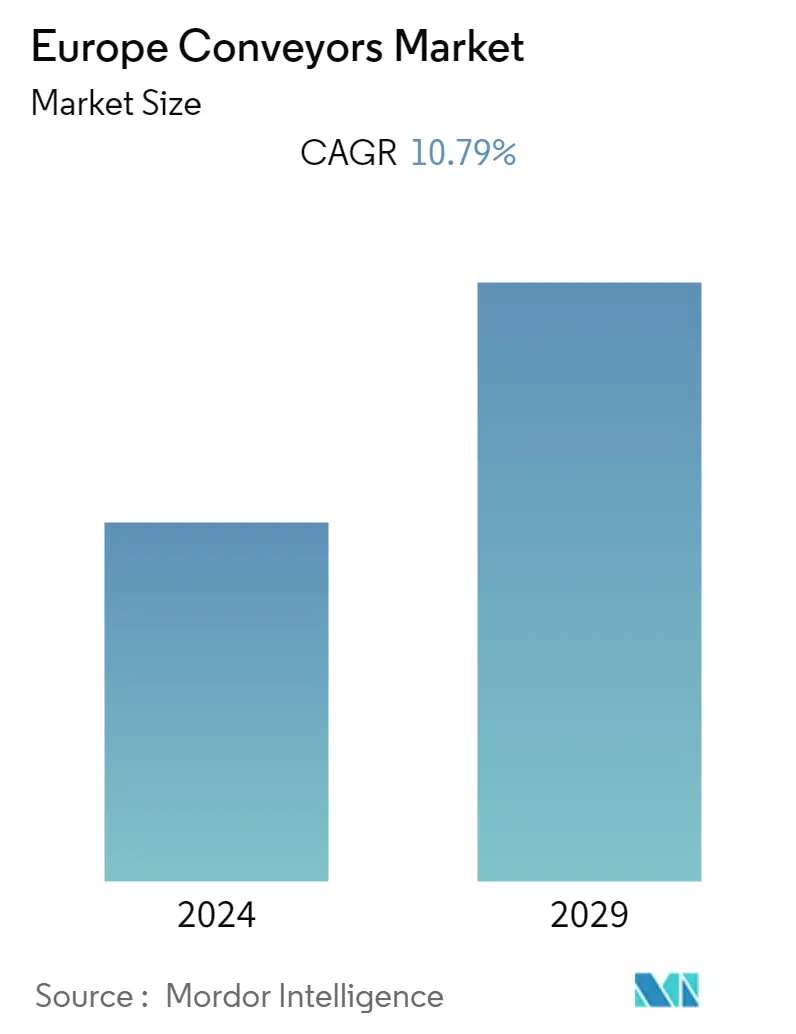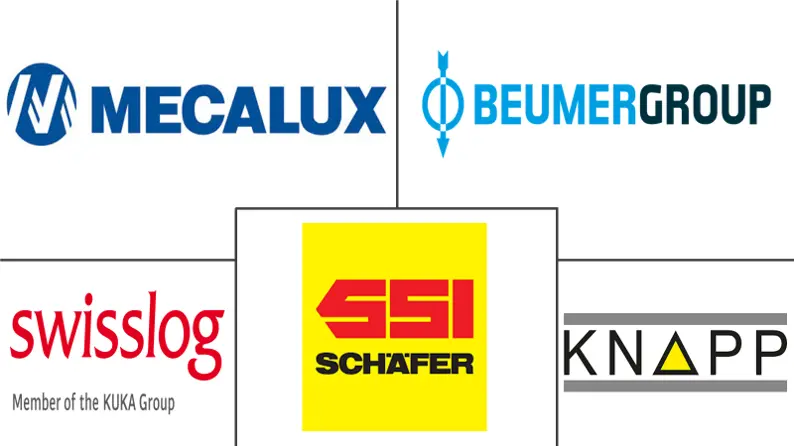Market Size of Europe Conveyors Industry

| Study Period | 2019 - 2029 |
| Base Year For Estimation | 2023 |
| Forecast Data Period | 2024 - 2029 |
| Historical Data Period | 2019 - 2022 |
| CAGR | 10.79 % |
| Market Concentration | Medium |
Major Players
*Disclaimer: Major Players sorted in no particular order |
Europe Conveyors Market Analysis
The Europe Conveyors Market is expected to register a CAGR of 10.79% over the forecast period from 2020 to 2025. Due to high labor costs, significant companies in Europe are expected to adopt conveyors. The growing drive toward increased output leads to greater adoption of these systems compared to substitutes, such as forklifts, because of their ease of installation and safety. Multiple industrial hubs in Europe, such as Germany, have witnessed a rise in the automotive industry where the assembly line production is automated. Conveyor systems reduce unnecessary practices involved in material shifting and help eliminate the idle time in carrying material between two assembly points.
- The European market is triggered by innovative products, logistical changes, or consumer shifts; hence, the sales outlets have already undergone several structural changes. With multiple per-capita levels of retail space and relatively low productivity, highly mature markets are at a comparatively higher risk of experiencing a contraction in the future. Hence, retailers are increasingly investing in automated storage, thereby contributing considerably toward saving the retail space. The growth in warehouse automation adoption rates, such as conveyors in this region, is mainly fueled by the rapid increase in e-commerce and retail investments.
- Driven by the national and global e-commerce market growth, there has been an advancement in parcels' volume growth in the region. According to the 2019 European E-commerce Report, the increase in online sales was more than 13%, and the estimated total sales were EUR 621 billion. In November 2019, Deutsche Post DHL Group also opened a mega parcel center in Bochum with a sorting capacity of up to 50,000 shipments per hour. Further, Royal Mail installed automated machinery, consisting of conveyor belts and scanning technology, in its Bristol center in July 2019, to speed up the sorting of parcels. The company is planning to increase the use of machines for sorting parcels to 80% within that time, up from the current rate of 12%.
- In September 2019, QC Conveyors announced expanding its product offering to include the Motion06 curve belt conveyor modules. Motion06, an Austria-based company, joined the Duravant LLC via acquisition, and along with QC Conveyors, is part of Duravant's Material Handling Solutions group. The Motion06 curve belt conveyors allow users to maintain product orientation in applications where a turn is required between two straight conveyors. By keeping the same product orientation at both the infeed and outfeed, the conveyors ensure the product is delivered in the perfect exposure for applications that require consistently faced product.
- With the outbreak of COVID-19, European restaurants are reopening amid challenging conditions such as infection waves, mandated reductions in seating capacity, and consumer safety concerns. Contactless dining will make restaurants to operate with fewer challenges and more confidence. In July 2020, Yo!, a Japanese restaurant chain, announced to launch its upgraded conveyor belt at 18 sites across the United Kingdom. Customers visiting the restaurants will experience a contactless process as part of the Government's safety guidelines. Diners will scan a QR code and order and pay for their food via their phone's digital menu. Dishes freshly prepared in each store's kitchen will arrive straight to the guest on the new conveyor belt.
Europe Conveyors Industry Segmentation
Conveyor systems are mechanical devices or assemblies that are used to transport various materials with little effort. There are different kinds of conveyor systems, usually consisting of a frame that supports either wheels, rollers, or a belt, upon which the materials move from one place to another. The scope of the study is currently focused exclusively on the European region.
| Product Type | |
| Belt | |
| Roller | |
| Pallet | |
| Overhead |
| End-User Industry | |
| Airport | |
| Retail | |
| Automotive | |
| Manufacturing | |
| Food and Beverage | |
| Pharmaceuticals | |
| Mining |
| Country | |
| United Kingdom | |
| France | |
| Germany | |
| Italy | |
| Spain | |
| The Netherlands | |
| Rest of Europe |
Europe Conveyors Market Size Summary
The European conveyor systems market is experiencing significant growth, driven by the increasing need for automation across various industries. High labor costs and the push for enhanced productivity are prompting companies to adopt conveyor systems over traditional methods like forklifts, due to their ease of installation and safety benefits. The automotive sector, particularly in Germany, is a key driver, with automated assembly lines reducing idle time and streamlining production processes. Additionally, the rise of e-commerce and retail investments is fueling the demand for warehouse automation, including conveyor systems, as businesses seek to optimize space and improve efficiency. The market is characterized by innovation and logistical changes, with retailers and logistics providers investing in automated storage solutions to keep pace with evolving consumer demands.
The competitive landscape of the European conveyor systems market is moderately fragmented, with several domestic and international players vying for market share. Companies like SSI Schaefer AG, Mecalux SA, and BEUMER Group GmbH & Co. KG are at the forefront, focusing on product innovation and strategic mergers and acquisitions to strengthen their market positions. The airport industry also contributes to market growth, with increased demand for reliable and efficient baggage handling systems. Despite challenges posed by the COVID-19 pandemic, which temporarily disrupted air travel and logistics, the market is poised for recovery as restrictions ease and demand for automated solutions continues to rise. The integration of smart technologies and automated systems in sectors such as food and beverage, automotive, and logistics underscores the market's potential for further expansion in the coming years.
Europe Conveyors Market Size - Table of Contents
-
1. MARKET DYNAMICS
-
1.1 Market Overview
-
1.2 Market Drivers
-
1.2.1 High Labor Wages in the European Region
-
1.2.2 Rapid Growth of E-commerce
-
-
1.3 Market Restraints
-
1.3.1 High Cost of Implementation
-
-
1.4 Industry Value Chain Analysis
-
1.5 Industry Attractiveness - Porter's Five Forces Analysis
-
1.5.1 Bargaining Power of Suppliers
-
1.5.2 Bargaining Power of Buyers
-
1.5.3 Threat of New Entrants
-
1.5.4 Intensity of Competitive Rivalry
-
1.5.5 Threat of Substitutes
-
-
1.6 Assessment on the impact due to COVID-19
-
-
2. MARKET SEGMENTATION
-
2.1 Product Type
-
2.1.1 Belt
-
2.1.2 Roller
-
2.1.3 Pallet
-
2.1.4 Overhead
-
-
2.2 End-User Industry
-
2.2.1 Airport
-
2.2.2 Retail
-
2.2.3 Automotive
-
2.2.4 Manufacturing
-
2.2.5 Food and Beverage
-
2.2.6 Pharmaceuticals
-
2.2.7 Mining
-
-
2.3 Country
-
2.3.1 United Kingdom
-
2.3.2 France
-
2.3.3 Germany
-
2.3.4 Italy
-
2.3.5 Spain
-
2.3.6 The Netherlands
-
2.3.7 Rest of Europe
-
-
Europe Conveyors Market Size FAQs
What is the current Europe Conveyors Market size?
The Europe Conveyors Market is projected to register a CAGR of 10.79% during the forecast period (2024-2029)
Who are the key players in Europe Conveyors Market?
SSI Schaefer AG, Mecalux SA, BEUMER Group GmbH & Co. KG, KNAAP AG and KUKA AG (Swisslog AG) are the major companies operating in the Europe Conveyors Market.

